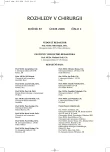Spontaneous Rupture of Ductus Choledochus in Acute Pancreatitis – a Case Report
Authors:
L. Lakyová; I. Toncr; J. Belák; R. Šimon; T. Toporcer; J. Vajó; J. Radoňak
Authors‘ workplace:
Fakultná nemocnica L. Pasteura, Košice, prednosta kliniky: MUDr. J. Belák, Ph. D.
; II. chirurgická klinika, Lekárska fakulta Univerzity Pavla Jozefa Šafárika, Košice, Slovenská republika
Published in:
Rozhl. Chir., 2008, roč. 87, č. 2, s. 92-95.
Category:
Monothematic special - Original
Overview
Spontaneous perforation of biliary tree is a rare disease. There are only a few case - reports published in the literature. Due to little success in the preoperative diagnosis, surgical treatment is delayed, which in a high percentage results into fatal complications. Surgeons` opinions of operative treatment in such cases are controversial, but the primary choice is decompressing drainage of biliary tree.
Authors of this report present a case of 71 years old woman admitted to the second surgical clinic with the diagnosis of acute pancreatitis. Because of developing signs of peritoneal irritation, the patient was referred for a surgical procedure with the finding of biliary peritonitis and the rupture of ductus choledochus. In the above case, the diagnosis was made peroperatively, where the surgical treatment consisted of drainage of ductus choledochus by Kehr T drain and cholecystestomy by inserting Malecoat catheter into gallbladder. Postoperative period was without complications, the T drain was removed on the 28th day after operation and Malecoat catheter was also removed two days later. Three years after the operation, the patient is in good physical condition with free bile passage according to ERCP.
The aim of this report is to bring the attention to this rare, but more importantly serious cause of origin of sudden abdominal event, in order to increase the interception rate concerning preoperative periods and consequent satisfactory treatment.
Key words:
spontaneous perforation – biliary tree – pankreatitis – peritonitis biliaris
Sources
1. Hasegawa, T., Udatsu, Y., Kamiyama, M., Kimura, T., Sasaki, T. A. Does pancreatico-biliary maljunction play a role in spontaneous perforation of the bile duct in children? Pediatric Surgery Interna-tional, 2000, 16, 8, s. 550–553.
2. Rege, SA, Lambe, S., Sethi, H., Gandhi A., Rohondia, O. Spontaneous common bile duct perforation in adult: a case report and review. Int. Surg., 2002, 87, s. 81–82.
3. Goldberg, D., Rosenfeld, D., Underberg-D. Spontaneous biliary perforation: biloma resembling a small duplication cyst (case report). Journal of pediatric gastroenterology and nutrition, 2000, 31, 2, s. 201–203.
4. Talwar, N., Andley, M., Ravi, B., Kumar, A. Spontaneous biliary tract perforations: an unusual cause of peritonitis. Report of two cases and review of literature. World. J. Emer Surg. 2006, 1 : 21.
5. Shenoy, V. G., Jawale, S. A., Oak, S. N., Kulkarni, B. K. Anomalous pancreaticobiliary union and chronic pancreatitis: rare presentation with biliary peritonitis. Pediatr. Surg. Int., 2001, 17, 7, s. 549–551.
6. Radoňak, J., Vajó, J., Jéger, T., Stebnický, M.,Eperješi, O. Opakované akútne krvácanie do duodena ako príznak začínajúceho Bouveretového syndrómu. Rozhl. Chir., 2000, roč. 79, č. 6, s. 228–230.
7. Sai Prasad, S., Hon Chui, Ch., Low, Y., Chia Li Chong, Sundfor Jacobsen, A. Bile Duct Perforation in Children: Is it Truly Spontaneous? Ann. Acad. Med. Singapore, 2006, 35, s. 905–908.
8. Nyamannawar, Babu, M., Kanishka, D. Spontaneous infantile choledochal cyst perforation. Clinical Brief. 2007, 74, 3, s. 299–300.
9. Meena, N., Gates, J., Ferzoco, S. J. Hepatic Duct Confluence Injury in Blunt Abdominal Trauma: Case Report and Synopsis on Management. Surgical Laparoscopy, Endoscopy & Percutaneous Techniques. 2003, 13, 5, s. 350–352.
10. Sauper, T., Lanthaler, M., Weissenboeck, E., Nehoda, H. .Spontaneous hepatic duct perforation in pregnancy: a case report and review of the literature. Gynecological surgery, 2004, 1, 4, s. 271–273.
11. Takahashi, K., Okabe, Y., Orino, A., Imai, Y., Yazumi, S. Spontaneous rupture of a biliary diverticulum in the distal common bile duct, with formation of a retroperitoneal biloma. Gastrointestinal Endoscopy, 2005, 61, 6, s. 783–787.
12. Kiresi, D., Karabacakoglu, A., Dilsiz, A., Karaköse, S. Spontaneous rupture of choledochal cyst presenting in childhood. The Turkish Journal of Pediatrics., 2005, 47, 3, s. 283–286.
13. Sung-Bum, Kang, Ho-Seong, Han, Seog Ki, Min. Nontraumatic Perforation of the Bile Duct in Adults. Arch. Surg., 2004, 139, s. 1083–1087.
14. Maheshwari, M., Parekh, B. R., Lahoti, B. K. Biliary peritonitis: A rare presentation of perforated choledochal cyst. Indian Pediatric., 2002, 39, s. 588–592.
15. Paladugu, R., Rau, A., Schein, M., Wise, L. Spontaneous perforation of the hepatic duct in adults. Dig. Surg., 1998, 15, s. 417–420.
16. Xanthakos, S. A., Yazigi, N. A., Ryckman, F. C., Arkovitz, M. S. Spontaneous Perforation of the Bile Duct in Infancy: A Rare but Important Cause of Irritability and Abdominal Distension [Case Report]. Journal of Pediatric Gastroenterology and Nutrition, 2003, 36, 2, s. 287–291.
17. Kasat, L. S., Borwankar, S. S., Jain, M. Spontaneous perforation of the extrahepatic bile duct in an infant. Pediatr. Surg. Int., 2001, 17, s. 463–464.
18. Bingol-Kologlu, M., Karnak, I., Ocal, T. Idiopathic perforation of the bile duct in an infant. J. Pediatr. Gastroenterol. Nutr., 2000, 31, s. 83–85.
19. Chikamori, F., Kuniyoshi, N., Shibuya, S. Y. Early scheduled laparoscopic cholecystectomy following percutaneous transhepatic gallbladder drainage for patients with acute cholecystitis. Surgical Endoscopy, 2002, 16, 12, s. 1704–1707.
Labels
Surgery Orthopaedics Trauma surgeryArticle was published in
Perspectives in Surgery

2008 Issue 2
- Metamizole at a Glance and in Practice – Effective Non-Opioid Analgesic for All Ages
- Metamizole in perioperative treatment in children under 14 years – results of a questionnaire survey from practice
- Possibilities of Using Metamizole in the Treatment of Acute Primary Headaches
Most read in this issue
- „Tension Free“ Method in Inguinal Hernioplasty Using CHS 100 Mesh – Our Experience
- Benefits of Intraoperative N. Laryngeus Recurrens Neuromonitoring in Thyroid Surgery
- Spontaneous Rupture of Ductus Choledochus in Acute Pancreatitis – a Case Report
- Surgical Management of Proximal Humeral Fractures Using the Hackethal (Zifko) Method – A Case Review
